
How to Test a Varistor: Step-by-Step Instructions
Global electronic component supplier ERSAELECTRONICS: Rich inventory for one-stop shopping. Inquire easily, and receive fast, customized solutions and quotes.
What is a Varistor?

A Varistor is a nonlinear resistor (VDR) that varies in voltage. In contrast to a normal resistor, which provides consistent resistance to current flow, the resistance of a varistor varies significantly with applied voltage. A varistor has extremely high resistance and functions nearly like an open circuit at standard operating voltages. However, the varistor's resistance drops sharply in the event of a voltage surge that exceeds its rated level, permitting a surge current to pass through it. By doing this, the extra voltage is successfully redirected away from the vulnerable components it is shielding.
What Does a Varistor Do?
A varistor's main job is to clamp short-lived voltage spikes. Electronic devices can be harmed or destroyed by these spikes, which are frequently brought on by lightning strikes, power surges, or switching events. Varistors serve as a sacrificial shield by deflecting these surges, absorbing the extra energy, and protecting downstream components.
Why Varistor is Used?
Varistors are frequently utilized in a variety of electronic circuits because of:
Simplicity: They don't need complicated configurations or external control circuits.
Fast Response Time: Varistors successfully clamp voltage spikes in nanoseconds by responding to them with lightning speed.
Bidirectional Protection: The majority of varistors provide defense against transients of both positive and negative voltage.
Cost-Effectiveness: When compared to certain other surge protection techniques, varistors provide a more affordable option.
Video related to Varistor
How Does a Varistor Work?
Varistors are composed of a ceramic semiconductor material, typically zinc oxide (ZnO). This material takes the form of small connections between the ZnO grains, or grain boundaries. These junctions function as barriers that obstruct current passage and provide significant resistance at typical working voltages. But when a voltage surge higher than the clamping voltage of the varistor is applied, the grain boundaries ionize, and the current flows more easily. The protected circuit is efficiently bypassed by this surge current, preventing harm to it.
How to Test a Varistor?
Here's a step-by-step guide on how to test a varistor:
Tools and Materials:
Digital Multimeter
(Optional) DC Power Supply
Safety Precautions:
Always discharge any capacitors in the circuit before testing.
Ensure the power supply is off before working on any electronic device.
Steps:
Visual Inspect: Check the varistor for any visible damage, such as cracks, discoloration, or bulging, before testing. These symptoms might point to a malfunctioning part.
Disconnect the Varistor: To conduct isolated testing, desolder or remove the varistor from the circuit board.
Set Multimeter: Select the resistance (Ω) mode on your multimeter.
Test for Open or Short: Start by touching the multimeter probes to the varistor's opposing leads. On the multimeter, a good varistor should display an "Open" reading (OL, or very high resistance). Next, make a quick contact between the probes. When you separate the probes, the meter should show very low resistance (around 0 Ω) and then revert to a high resistance measurement. A varistor that is permanently shorted is shown by a low resistance value; an open circuit is indicated by a reading of zero. Keep in mind that this is an early test. Voltage application is necessary for a more definitive test.
Optional Voltage Test (Use with Caution): To conduct a more thorough test, you can mimic a voltage surge using a DC power supply that has the proper voltage and current constraints. To protect the power supply and varistor, this procedure should be used carefully. Link the varistor's leads to the power source, then progressively raise the voltage while keeping an eye on the current. When the voltage approaches its clamping voltage, a good varistor will exhibit a noticeable increase in current flow, with limited current flow at normal levels. A failed varistor is indicated by an abrupt spike in current at a lower voltage.
Recall that the datasheet for the particular varistor you are evaluating should always be consulted for suggested testing methods and voltage restrictions.
Where is Varistor Used?
Varistors are used to protect against voltage spikes in a variety of electrical equipment, such as:
Power Supplies: To guard against surges from the main power line, varistors are frequently seen in power supplies.
Consumer Electronics: Varistors are frequently used for surge protection in televisions, computers, audio equipment, and other consumer electronics.
Telecommunication Equipment: Varistors protect delicate communication equipment from brief voltage spikes and lightning strikes.
Industrial Automation Systems: To protect against voltage fluctuations that could cause operational disruptions, industrial control systems rely on varistors.
Automotive Electronics: Varistors are essential for shielding today's sophisticated electronics from voltage spikes brought on by alternator switching or other outside influences.
Where to Buy Varistor?
Varistors are easily obtained from several online and physical sources of electronic components. Here are some popular options:
Digi-Key
Mouser Electronics
Newark (element14)
Local electronics stores
Make sure the varistor you buy has the right voltage rating and current handling capabilities for the use you have in mind. This important information will be available on the varistor's datasheet.
What Happens When a Varistor Fails?
A failed varistor can leave your electronic devices vulnerable to voltage spikes. Here are some potential consequences:
Component Damage: Voltage surges have the potential to harm or even destroy delicate circuit components if the varistor isn't protecting them.
Device Malfunction: A surge may cause a device that isn't operating normally to behave erratically or completely fail.
Safety Hazards: A failed varistor may produce heat in extreme circumstances, which could result in a fire.
Conclusion
In the realm of electronics, varistors are silent protectors, defending our gadgets from the imperceptible danger of voltage spikes. You may guarantee the continuous protection of your priceless electronics by being aware of varistors' functions, testing procedures, and applications. Recall that replacing a faulty varistor as soon as possible can save future expensive repairs or replacements.
FAQs
What is a varistor used for?
A varistor is like a bodyguard for your electronics. Under normal voltage, it functions largely undetectable, but in the event of a surge, it intervenes to shunt the excess current away, safeguarding your gadget. They protect from power surges, lightning strikes, and even circuit glitches in a variety of equipment. Just remember that they could have a small current leak and can wear out over time.
What is the difference between a varistor and a resistor?
Here's the key difference between a varistor and a resistor:
Resistor: Regardless of voltage, a resistor provides a fixed resistance to current flow in a circuit. It controls current flow at a steady pace like a valve.
Varistor: A resistor that changes in voltage. The voltage that is applied affects its resistance. It functions like an open circuit with an extremely high resistance at standard voltage. However, it becomes far less resistant during a voltage spike, which enables it to redirect excess current and safeguard the circuit.
Can a circuit work without a varistor?
A circuit can often operate without a varistor, however, this is dependent on a few factors:
Presence of Voltage Spikes: A varistor may not be necessarily required for fundamental functionality if the circuit operates in a stable environment with little chance of voltage spikes (such as a steady power source).
Component Sensitivity: A key factor is the circuit's parts' susceptibility to damage. In circuits with components that are extremely vulnerable to even small voltage variations, the protection value of a varistor increases.
Cost vs Risk Tolerance: A varistor typically has a cheap cost. By including one, you can offer another line of defense against any damage caused by unplanned surges. Most of the time, the choice comes down to comparing the possible expense of replacing surge-damaged components with the cost of installing a varistor as a preventative measure.
How long do varistors last?
A varistor's lifespan is dependent upon several aspects, such as temperature, the operational environment, and the number of surge occurrences it has endured. Varistors are often made to last the entire life of the object they are guarding.
Related Articles
- ·Insulated Gate Bipolar Transistor (IGBT): The Dragon Rider of High-Power Circuits
- ·Transistor Symbol: The Blockbuster Guide (With Zero Boring)
- ·ICD Electronics: Tiny Lightning, Relentless Reliability
- ·Smart Pill Dispensing Electronics: From Missed Doses to Mission Control
- ·Conditional Access Module (CAM): The Pay-TV Gatekeeper Engineers Actually Enjoy Reading About
- ·NC Formula Semiconductor: The Blockbuster Guide You Didn’t Know You Needed
- ·Electrosurgery Electronics: Turning RF Into a Surgical Superpower
- ·Endoscopic Imaging Electronics: Tiny Optics, Big Picture
- ·Instrument Cluster: The Dashboard Wizard That Makes You Feel Like Iron Man
- ·X-ray & CT Electronics: From Kilovolts to Reconstruction


















.png?x-oss-process=image/format,webp/resize,h_32)










